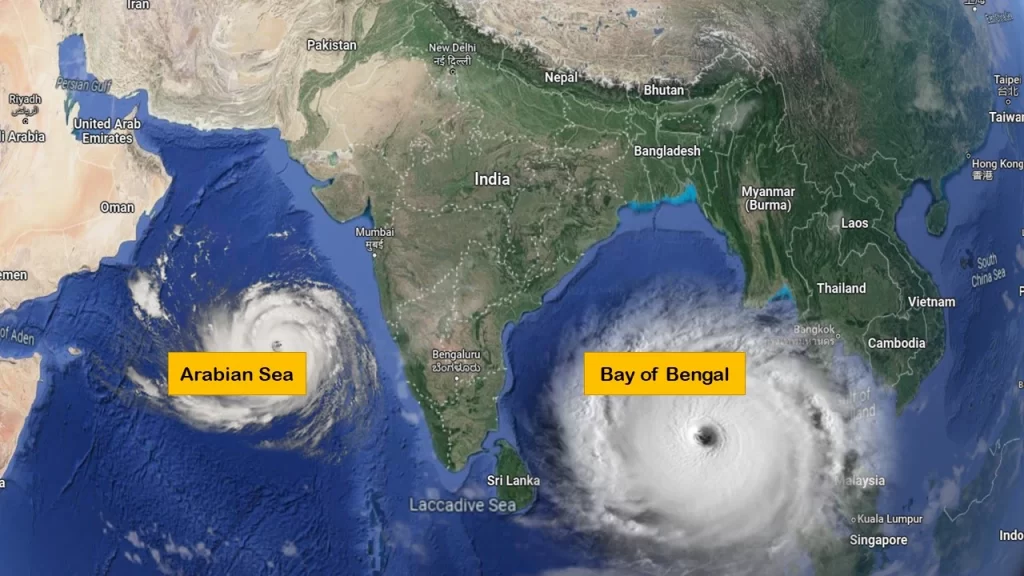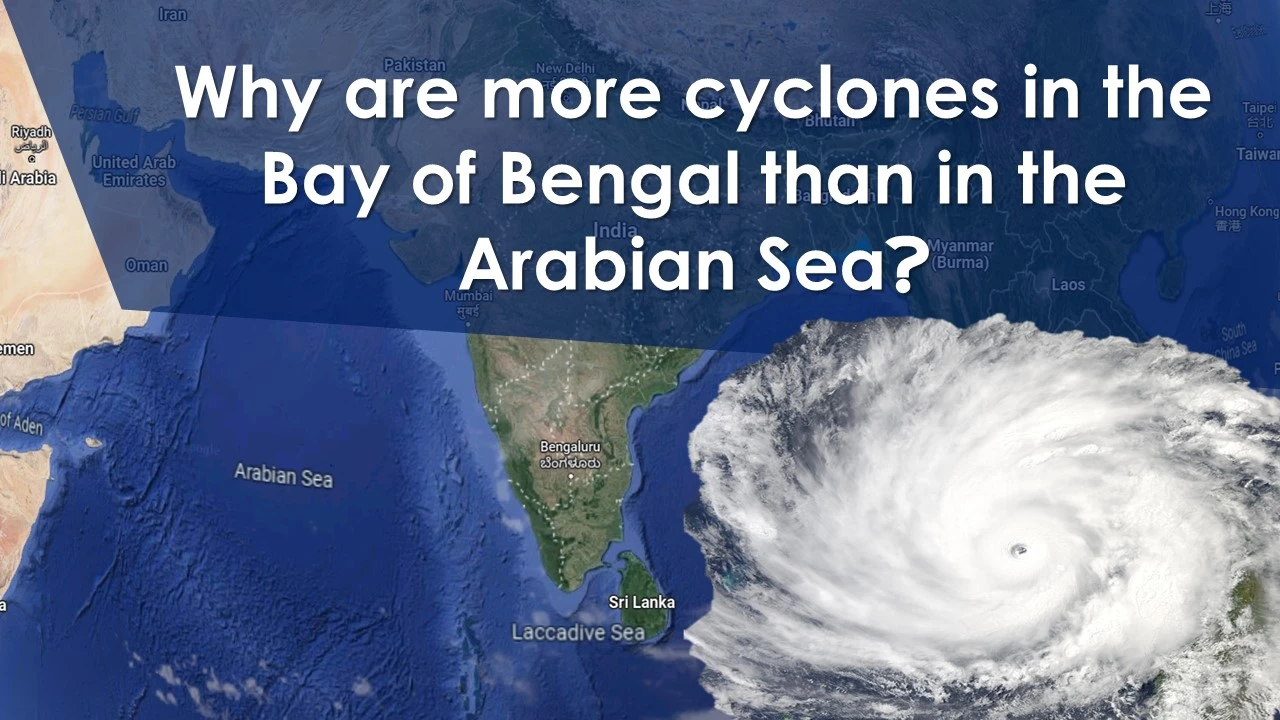Have you ever wondered why there are more cyclones in the Bay of Bengal than in the Arabian Sea? It’s a question that has plagued scientists for years, and despite all of their research, they still can’t seem to agree on an answer. Scientists are still trying to figure out why this is happening, but it’s clear that something is going on.
There’s something unusual happening in the Bay of Bengal. Over the past few decades, the area has seen more cyclones form than the Arabian Sea. Some believe that it has to do with the topography of the two seas, while others think that it’s related to the difference in water temperatures. Whatever the reason may be, one thing is for sure: The Bay of Bengal is a hotspot for cyclones.
In this blog post, we’ll take a closer look at what might be causing more cyclones in the Bay of Bengal than in the Arabian Sea and what it could mean for the region moving forward. Stay tuned!
⫸ The Bay of Bengal experiences more cyclones because of its unique geography:
There are more cyclones in the Bay of Bengal than in the Arabian Sea for several reasons.
First, the Bay of Bengal is more shallow than the Arabian sea, which means that there is more heat transfer from the water to the air. This increases the potential for moisture and instability, which are necessary ingredients for cyclone formation.
Second, the Bay of Bengal is surrounded by land on three sides, which provides a source of additional moisture and instability.
Third, the geometry of the Bay of Bengal – with its long, curved coastline – amplifies wind speeds as they funnel into the bay. This increases the destructive potential of any cyclone that forms here.
Taken together, these factors explain why more cyclones occur in the Bay of Bengal than in the Arabian Sea.
⫸ The Arabian Sea is much narrower, which means that cyclones have a harder time forming:
The Arabian Sea is much narrower than the Bay of Bengal, which means that cyclones have a harder time forming. The Arabian Sea is also deeper, so the waves are not as high as in the Bay of Bengal.
The Arabian Sea is bordered by Oman, Iran, Pakistan, India, and the Arabian Peninsula. The Arabian Peninsula is made up of countries like Kuwait, Bahrain, Qatar, United Arab Emirates, and Yemen. This partial landlocked position causes more salinity in the Arabian Sea.
The Same Condition causes low sea surface temperature (SST) and disadvantageous wind systems. That’s why there is the development of more cyclones in the Bay of Bengal than in the Arabian Sea.
⫸ The Bay of Bengal has a much larger area, so the storms can dissipate more easily:
The Bay of Bengal is a large body of water situated in the northeastern part of the Indian Ocean. It is bordered by India to the west, Bangladesh to the north, and Burma and Thailand to the east.
The bay is well-known for its tropical cyclones. Tropical cyclones form over warm ocean waters and typically bring heavy rains, strong winds, and storm surges.
The Bay of Bengal is particularly vulnerable to tropical cyclones because it has a wide expanse of shallow water. This shallow water heats up more quickly than deep water, providing the necessary conditions for storms to form.
In addition, the Bay of Bengal has a much larger area than other bodies of water in the region, so storms can dissipate more easily. As a result, the Bay of Bengal is one of the most active areas for tropical cyclone formation in the world. For the same reasons, more cyclones occur in the Bay of Bengal than in the Arabian Sea.
⫸ The landmass in the Bay of Bengal is much higher than in the Arabian sea, which leads to more vigorous weather patterns:
The Bay of Bengal is a large body of water that lies off the eastern coast of India. It covers an area of 1.2 million square kilometers, making it nearly twice the size of the Arabian Sea. The Bay of Bengal is also much shallower than the Arabian Sea, with an average depth of 2,734 meters.
The large size and shallow depth of the Bay of Bengal give it a significant influence on weather patterns in the region. The Bay of Bengal is responsible for the formation of several tropical cyclones each year, as well as the monsoon rains that bring relief from the hot summer temperatures.

The Bay of Bengal is also home to some of the world’s largest rivers, including the Ganges, Brahmaputra, and Irrawaddy. The combined flow of these rivers supplies a large amount of fresh water to the bay, which helps to moderate its temperature and salinity levels. Thus, more cyclones occur in the Bay of Bengal than in the Arabian Sea.
⫸ The monsoon season lasts longer in the Bay of Bengal, providing more opportunities for storms to form:
The monsoon season typically lasts from June to September in the Bay of Bengal. This extended timeframe provides more opportunities for storms to form.
Approximately two-thirds of all tropical cyclones that form in the North Indian Ocean occur during the monsoon season in the Bay of Bengal. Hence, more cyclones occur in the Bay of Bengal than in the Arabian Sea.
These storms can bring heavy rains, strong winds, and storm surge to coastal areas. As a result, residents in these regions need to be aware of the increased risk during the monsoon season and take steps to protect themselves and their property.
⫸ Conclusion:
The Bay of Bengal is a more favorable environment for cyclones to form and thrive because of the unique geography and weather patterns in the region. While it’s impossible to say definitively why more cyclones occur in the Bay of Bengal than in the Arabian Sea, this information can help us better prepare for these storms when they do occur.
What do you think? Do you live in an area that is prone to cyclones? Let us know in the comments how you prepare for them.
⫸ FAQs on "Why are more cyclones in the Bay of Bengal than in the Arabian Sea?"
1. Why are more cyclones in the Bay of Bengal than in the Arabian Sea?
The Bay of Bengal is more prone to cyclones than the Arabian Sea because it is surrounded by landmasses on three sides, while the Arabian Sea is open to the Indian Ocean.
The Bay of Bengal also has a large expanse of shallow water, which helps cyclones form more easily. Additionally, the Bay of Bengal is located in a region where the wind patterns are more conducive to cyclone formation.
2. List of cyclones in the Bay of Bengal:
There have been many cyclones in the Bay of Bengal over the years, some of the more notable ones include:
- Super Cyclone Nargis (2008)
- Cyclone Phailin (2013)
- Cyclone Hudhud (2014)
- Cyclone Bulbul (2019)
- Cyclone Fani (2019)
- Super Cyclone Amphan (2020)
- Cyclone Yaas (2021)
- Cyclone Jawad (2021)
- Cyclone Asani (2022)
3. List of cyclones in the Arabian Sea:
There have been fewer cyclones in the Arabian Sea than in the Bay of Bengal, but some notable ones include:
- Cyclone Gonu (2007)
- Cyclone Phet (2010)
- Cyclone Nada (2016)
- Cyclone Ockhi (2017)
- Cyclone Hikaa (2019)
- Cyclone Kyarr (2019)
- Cyclone Vayu (2019)
- Cyclone Maha (2019)
- Cyclone Nivar (2020)
- Cyclone Gulab (2021)
4. What are the consequences of a cyclone?
Cyclones can cause widespread damage and destruction, particularly if they make landfall. They can cause flooding, landslides, and damage to infrastructure and homes.
Cyclones can also disrupt transportation and communication networks. Additionally, cyclones can lead to loss of life, particularly if people are caught unaware or unable to evacuate to safety.
5. How can people protect themselves from cyclones?
There are a few things that people can do to protect themselves from cyclones:
Stay informed: Keep up to date with weather forecasts and warnings.
Evacuate: If you are in an area that is at risk of being affected by a cyclone, evacuate to a safe location.
Take shelter: When a cyclone is approaching, take shelter in a sturdy building.
Stay away from coastal areas: Cyclones can cause storm surges, so it is important to stay away from coastal areas when one is approaching.
Be prepared: Have an emergency kit ready in case you lose power or water.
Stay away from floodwaters: Floodwaters can contain contaminants and be dangerous to walk or drive through.
6. What is the difference between a cyclone in the Bay of Bengal and the Arabian Sea?
There are more cyclones in the Bay of Bengal than in the Arabian Sea because the Bay of Bengal is more prone to cyclonic activity. The Bay of Bengal is surrounded by land on three sides, while the Arabian Sea is open to the Indian Ocean.
Additionally, the Bay of Bengal has a large expanse of shallow water, which helps cyclones form more easily. The Bay of Bengal is also located in a region where the wind patterns are more conducive to cyclone formation.
7. What are the dangers of a cyclone?
While cyclones can bring heavy rains and flooding, they can also cause widespread damage and destruction. Cyclone winds can reach speeds of up to 200 kilometers per hour, and can down trees, damaged houses, and cause coastal erosion.
Cyclones can also create storm surges that can inundate coastal areas with seawater. Finally, cyclones can lead to landslides and flash floods.
8. How can I stay safe during a cyclone?
If you are in an area that is at risk of a cyclone, you should:
● Monitor the news and weather forecasts for updates on the cyclone
● Follow any evacuation orders that are issued
● Stay indoors in a safe location
● Keep away from windows and doors
● If possible, bring indoor plants and loose items inside
● Keep an emergency kit with you that includes food, water, and firs

